Corporate Strategy and Governance: McDonald's UK Case Study Analysis
VerifiedAdded on 2020/12/09
|31
|4981
|72
Report
AI Summary
This report provides an in-depth analysis of corporate governance and strategy at McDonald's in the United Kingdom. It begins with an introduction that outlines the background of the study, the problem statement concerning employee disputes over pay and zero-hour contracts, and the research methods employed, including both primary and secondary data collection and thematic analysis. A literature review establishes the theoretical framework, discussing corporate governance, corporate strategy, and their significance. The discussion section presents the findings from the primary research, which includes a questionnaire administered to McDonald's managers, and secondary research, providing context to the issues. The report examines the importance of corporate strategy and governance, the requirements for effective implementation, and the role of strategy in avoiding conflicts and motivating employees. The analysis also covers the need for improved employment policies and the link between corporate strategy and human resource management. The report concludes by offering recommendations to McDonald's management, aiming to resolve the issues and enhance corporate governance practices. The report uses both primary and secondary research to comprehend the issues faced by McDonald's in the UK.
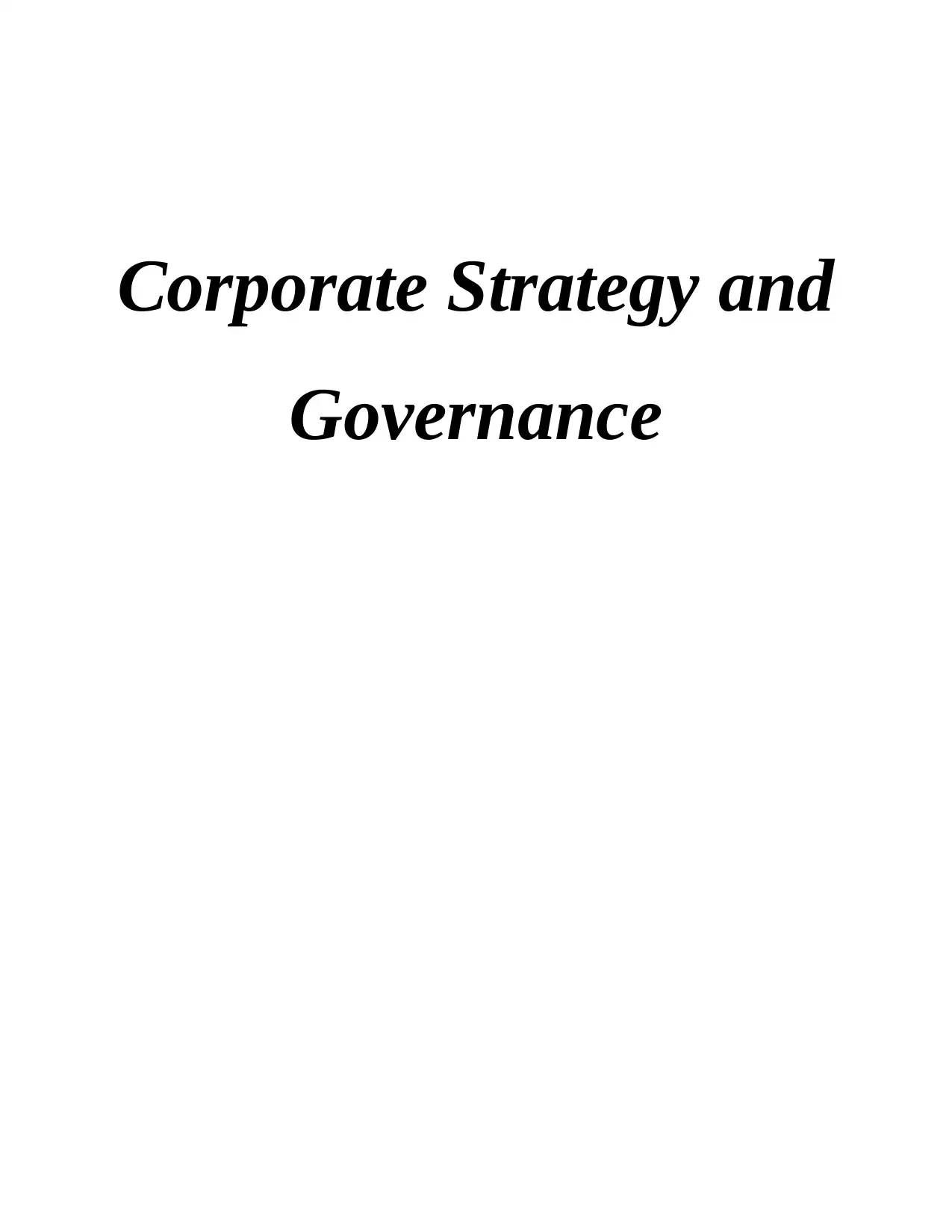
Corporate Strategy and
Governance
Governance
Paraphrase This Document
Need a fresh take? Get an instant paraphrase of this document with our AI Paraphraser
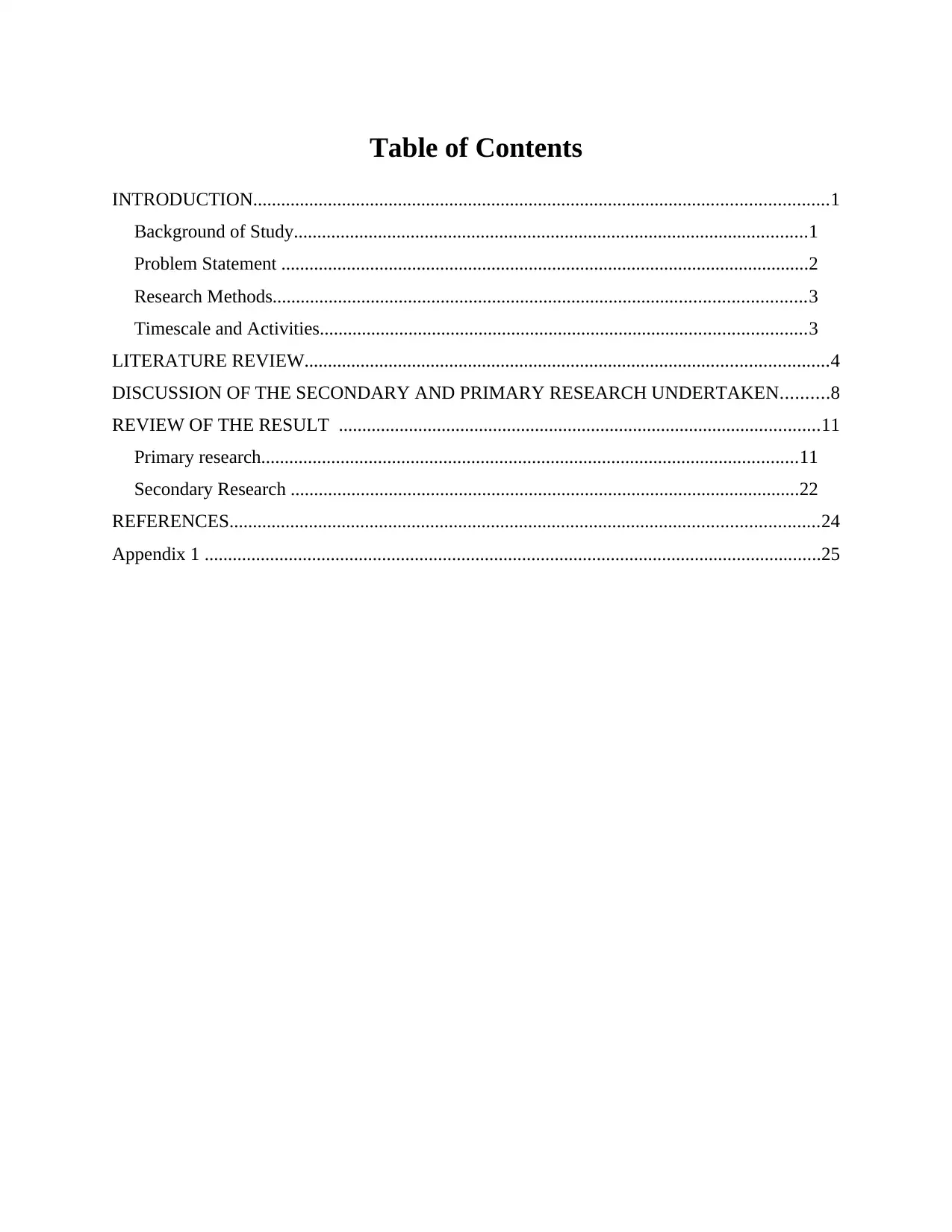
Table of Contents
INTRODUCTION...........................................................................................................................1
Background of Study..............................................................................................................1
Problem Statement .................................................................................................................2
Research Methods..................................................................................................................3
Timescale and Activities........................................................................................................3
LITERATURE REVIEW................................................................................................................4
DISCUSSION OF THE SECONDARY AND PRIMARY RESEARCH UNDERTAKEN..........8
REVIEW OF THE RESULT .......................................................................................................11
Primary research...................................................................................................................11
Secondary Research .............................................................................................................22
REFERENCES..............................................................................................................................24
Appendix 1 ....................................................................................................................................25
INTRODUCTION...........................................................................................................................1
Background of Study..............................................................................................................1
Problem Statement .................................................................................................................2
Research Methods..................................................................................................................3
Timescale and Activities........................................................................................................3
LITERATURE REVIEW................................................................................................................4
DISCUSSION OF THE SECONDARY AND PRIMARY RESEARCH UNDERTAKEN..........8
REVIEW OF THE RESULT .......................................................................................................11
Primary research...................................................................................................................11
Secondary Research .............................................................................................................22
REFERENCES..............................................................................................................................24
Appendix 1 ....................................................................................................................................25
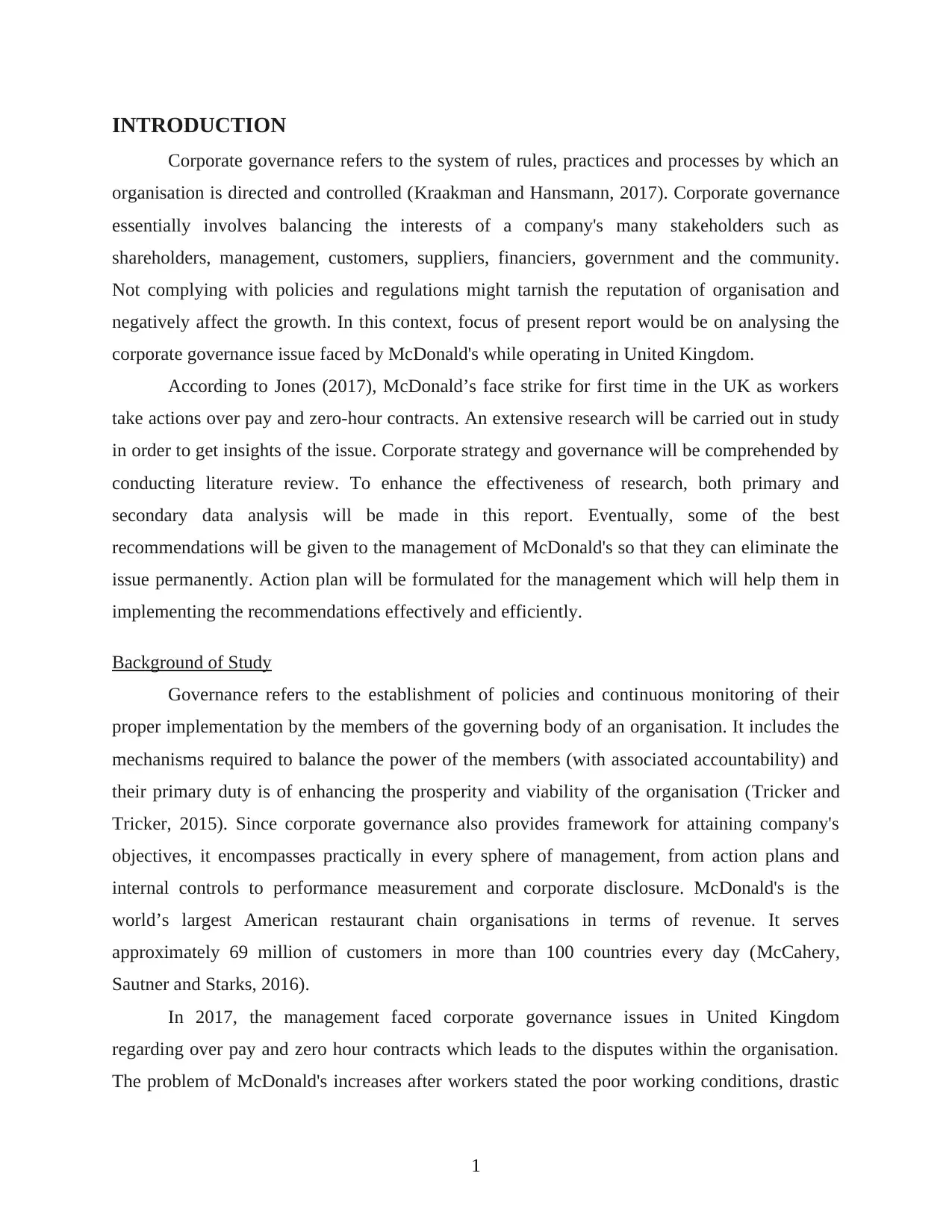
INTRODUCTION
Corporate governance refers to the system of rules, practices and processes by which an
organisation is directed and controlled (Kraakman and Hansmann, 2017). Corporate governance
essentially involves balancing the interests of a company's many stakeholders such as
shareholders, management, customers, suppliers, financiers, government and the community.
Not complying with policies and regulations might tarnish the reputation of organisation and
negatively affect the growth. In this context, focus of present report would be on analysing the
corporate governance issue faced by McDonald's while operating in United Kingdom.
According to Jones (2017), McDonald’s face strike for first time in the UK as workers
take actions over pay and zero-hour contracts. An extensive research will be carried out in study
in order to get insights of the issue. Corporate strategy and governance will be comprehended by
conducting literature review. To enhance the effectiveness of research, both primary and
secondary data analysis will be made in this report. Eventually, some of the best
recommendations will be given to the management of McDonald's so that they can eliminate the
issue permanently. Action plan will be formulated for the management which will help them in
implementing the recommendations effectively and efficiently.
Background of Study
Governance refers to the establishment of policies and continuous monitoring of their
proper implementation by the members of the governing body of an organisation. It includes the
mechanisms required to balance the power of the members (with associated accountability) and
their primary duty is of enhancing the prosperity and viability of the organisation (Tricker and
Tricker, 2015). Since corporate governance also provides framework for attaining company's
objectives, it encompasses practically in every sphere of management, from action plans and
internal controls to performance measurement and corporate disclosure. McDonald's is the
world’s largest American restaurant chain organisations in terms of revenue. It serves
approximately 69 million of customers in more than 100 countries every day (McCahery,
Sautner and Starks, 2016).
In 2017, the management faced corporate governance issues in United Kingdom
regarding over pay and zero hour contracts which leads to the disputes within the organisation.
The problem of McDonald's increases after workers stated the poor working conditions, drastic
1
Corporate governance refers to the system of rules, practices and processes by which an
organisation is directed and controlled (Kraakman and Hansmann, 2017). Corporate governance
essentially involves balancing the interests of a company's many stakeholders such as
shareholders, management, customers, suppliers, financiers, government and the community.
Not complying with policies and regulations might tarnish the reputation of organisation and
negatively affect the growth. In this context, focus of present report would be on analysing the
corporate governance issue faced by McDonald's while operating in United Kingdom.
According to Jones (2017), McDonald’s face strike for first time in the UK as workers
take actions over pay and zero-hour contracts. An extensive research will be carried out in study
in order to get insights of the issue. Corporate strategy and governance will be comprehended by
conducting literature review. To enhance the effectiveness of research, both primary and
secondary data analysis will be made in this report. Eventually, some of the best
recommendations will be given to the management of McDonald's so that they can eliminate the
issue permanently. Action plan will be formulated for the management which will help them in
implementing the recommendations effectively and efficiently.
Background of Study
Governance refers to the establishment of policies and continuous monitoring of their
proper implementation by the members of the governing body of an organisation. It includes the
mechanisms required to balance the power of the members (with associated accountability) and
their primary duty is of enhancing the prosperity and viability of the organisation (Tricker and
Tricker, 2015). Since corporate governance also provides framework for attaining company's
objectives, it encompasses practically in every sphere of management, from action plans and
internal controls to performance measurement and corporate disclosure. McDonald's is the
world’s largest American restaurant chain organisations in terms of revenue. It serves
approximately 69 million of customers in more than 100 countries every day (McCahery,
Sautner and Starks, 2016).
In 2017, the management faced corporate governance issues in United Kingdom
regarding over pay and zero hour contracts which leads to the disputes within the organisation.
The problem of McDonald's increases after workers stated the poor working conditions, drastic
1
⊘ This is a preview!⊘
Do you want full access?
Subscribe today to unlock all pages.

Trusted by 1+ million students worldwide
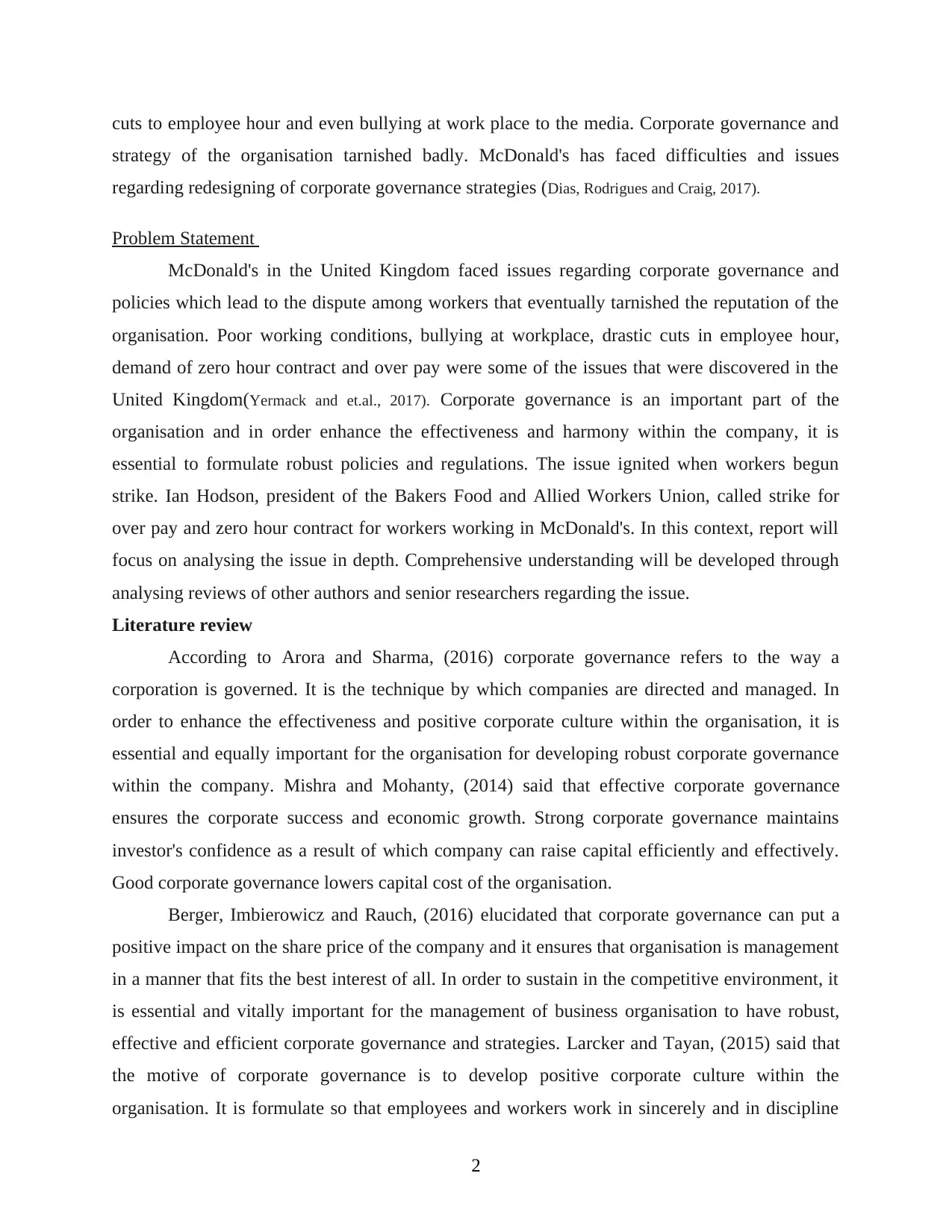
cuts to employee hour and even bullying at work place to the media. Corporate governance and
strategy of the organisation tarnished badly. McDonald's has faced difficulties and issues
regarding redesigning of corporate governance strategies (Dias, Rodrigues and Craig, 2017).
Problem Statement
McDonald's in the United Kingdom faced issues regarding corporate governance and
policies which lead to the dispute among workers that eventually tarnished the reputation of the
organisation. Poor working conditions, bullying at workplace, drastic cuts in employee hour,
demand of zero hour contract and over pay were some of the issues that were discovered in the
United Kingdom(Yermack and et.al., 2017). Corporate governance is an important part of the
organisation and in order enhance the effectiveness and harmony within the company, it is
essential to formulate robust policies and regulations. The issue ignited when workers begun
strike. Ian Hodson, president of the Bakers Food and Allied Workers Union, called strike for
over pay and zero hour contract for workers working in McDonald's. In this context, report will
focus on analysing the issue in depth. Comprehensive understanding will be developed through
analysing reviews of other authors and senior researchers regarding the issue.
Literature review
According to Arora and Sharma, (2016) corporate governance refers to the way a
corporation is governed. It is the technique by which companies are directed and managed. In
order to enhance the effectiveness and positive corporate culture within the organisation, it is
essential and equally important for the organisation for developing robust corporate governance
within the company. Mishra and Mohanty, (2014) said that effective corporate governance
ensures the corporate success and economic growth. Strong corporate governance maintains
investor's confidence as a result of which company can raise capital efficiently and effectively.
Good corporate governance lowers capital cost of the organisation.
Berger, Imbierowicz and Rauch, (2016) elucidated that corporate governance can put a
positive impact on the share price of the company and it ensures that organisation is management
in a manner that fits the best interest of all. In order to sustain in the competitive environment, it
is essential and vitally important for the management of business organisation to have robust,
effective and efficient corporate governance and strategies. Larcker and Tayan, (2015) said that
the motive of corporate governance is to develop positive corporate culture within the
organisation. It is formulate so that employees and workers work in sincerely and in discipline
2
strategy of the organisation tarnished badly. McDonald's has faced difficulties and issues
regarding redesigning of corporate governance strategies (Dias, Rodrigues and Craig, 2017).
Problem Statement
McDonald's in the United Kingdom faced issues regarding corporate governance and
policies which lead to the dispute among workers that eventually tarnished the reputation of the
organisation. Poor working conditions, bullying at workplace, drastic cuts in employee hour,
demand of zero hour contract and over pay were some of the issues that were discovered in the
United Kingdom(Yermack and et.al., 2017). Corporate governance is an important part of the
organisation and in order enhance the effectiveness and harmony within the company, it is
essential to formulate robust policies and regulations. The issue ignited when workers begun
strike. Ian Hodson, president of the Bakers Food and Allied Workers Union, called strike for
over pay and zero hour contract for workers working in McDonald's. In this context, report will
focus on analysing the issue in depth. Comprehensive understanding will be developed through
analysing reviews of other authors and senior researchers regarding the issue.
Literature review
According to Arora and Sharma, (2016) corporate governance refers to the way a
corporation is governed. It is the technique by which companies are directed and managed. In
order to enhance the effectiveness and positive corporate culture within the organisation, it is
essential and equally important for the organisation for developing robust corporate governance
within the company. Mishra and Mohanty, (2014) said that effective corporate governance
ensures the corporate success and economic growth. Strong corporate governance maintains
investor's confidence as a result of which company can raise capital efficiently and effectively.
Good corporate governance lowers capital cost of the organisation.
Berger, Imbierowicz and Rauch, (2016) elucidated that corporate governance can put a
positive impact on the share price of the company and it ensures that organisation is management
in a manner that fits the best interest of all. In order to sustain in the competitive environment, it
is essential and vitally important for the management of business organisation to have robust,
effective and efficient corporate governance and strategies. Larcker and Tayan, (2015) said that
the motive of corporate governance is to develop positive corporate culture within the
organisation. It is formulate so that employees and workers work in sincerely and in discipline
2
Paraphrase This Document
Need a fresh take? Get an instant paraphrase of this document with our AI Paraphraser
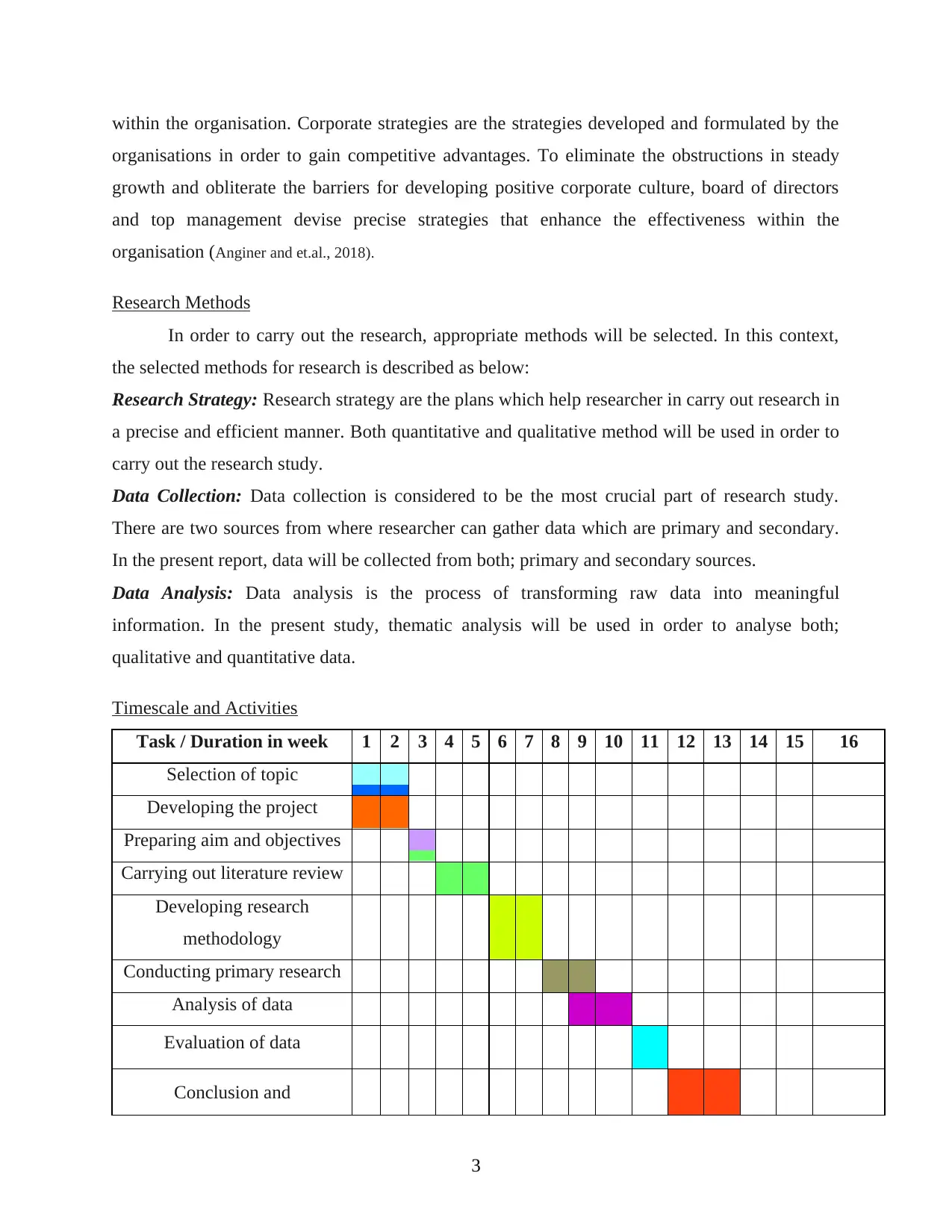
within the organisation. Corporate strategies are the strategies developed and formulated by the
organisations in order to gain competitive advantages. To eliminate the obstructions in steady
growth and obliterate the barriers for developing positive corporate culture, board of directors
and top management devise precise strategies that enhance the effectiveness within the
organisation (Anginer and et.al., 2018).
Research Methods
In order to carry out the research, appropriate methods will be selected. In this context,
the selected methods for research is described as below:
Research Strategy: Research strategy are the plans which help researcher in carry out research in
a precise and efficient manner. Both quantitative and qualitative method will be used in order to
carry out the research study.
Data Collection: Data collection is considered to be the most crucial part of research study.
There are two sources from where researcher can gather data which are primary and secondary.
In the present report, data will be collected from both; primary and secondary sources.
Data Analysis: Data analysis is the process of transforming raw data into meaningful
information. In the present study, thematic analysis will be used in order to analyse both;
qualitative and quantitative data.
Timescale and Activities
Task / Duration in week 1 2 3 4 5 6 7 8 9 10 11 12 13 14 15 16
Selection of topic
Developing the project
Preparing aim and objectives
Carrying out literature review
Developing research
methodology
Conducting primary research
Analysis of data
Evaluation of data
Conclusion and
3
organisations in order to gain competitive advantages. To eliminate the obstructions in steady
growth and obliterate the barriers for developing positive corporate culture, board of directors
and top management devise precise strategies that enhance the effectiveness within the
organisation (Anginer and et.al., 2018).
Research Methods
In order to carry out the research, appropriate methods will be selected. In this context,
the selected methods for research is described as below:
Research Strategy: Research strategy are the plans which help researcher in carry out research in
a precise and efficient manner. Both quantitative and qualitative method will be used in order to
carry out the research study.
Data Collection: Data collection is considered to be the most crucial part of research study.
There are two sources from where researcher can gather data which are primary and secondary.
In the present report, data will be collected from both; primary and secondary sources.
Data Analysis: Data analysis is the process of transforming raw data into meaningful
information. In the present study, thematic analysis will be used in order to analyse both;
qualitative and quantitative data.
Timescale and Activities
Task / Duration in week 1 2 3 4 5 6 7 8 9 10 11 12 13 14 15 16
Selection of topic
Developing the project
Preparing aim and objectives
Carrying out literature review
Developing research
methodology
Conducting primary research
Analysis of data
Evaluation of data
Conclusion and
3
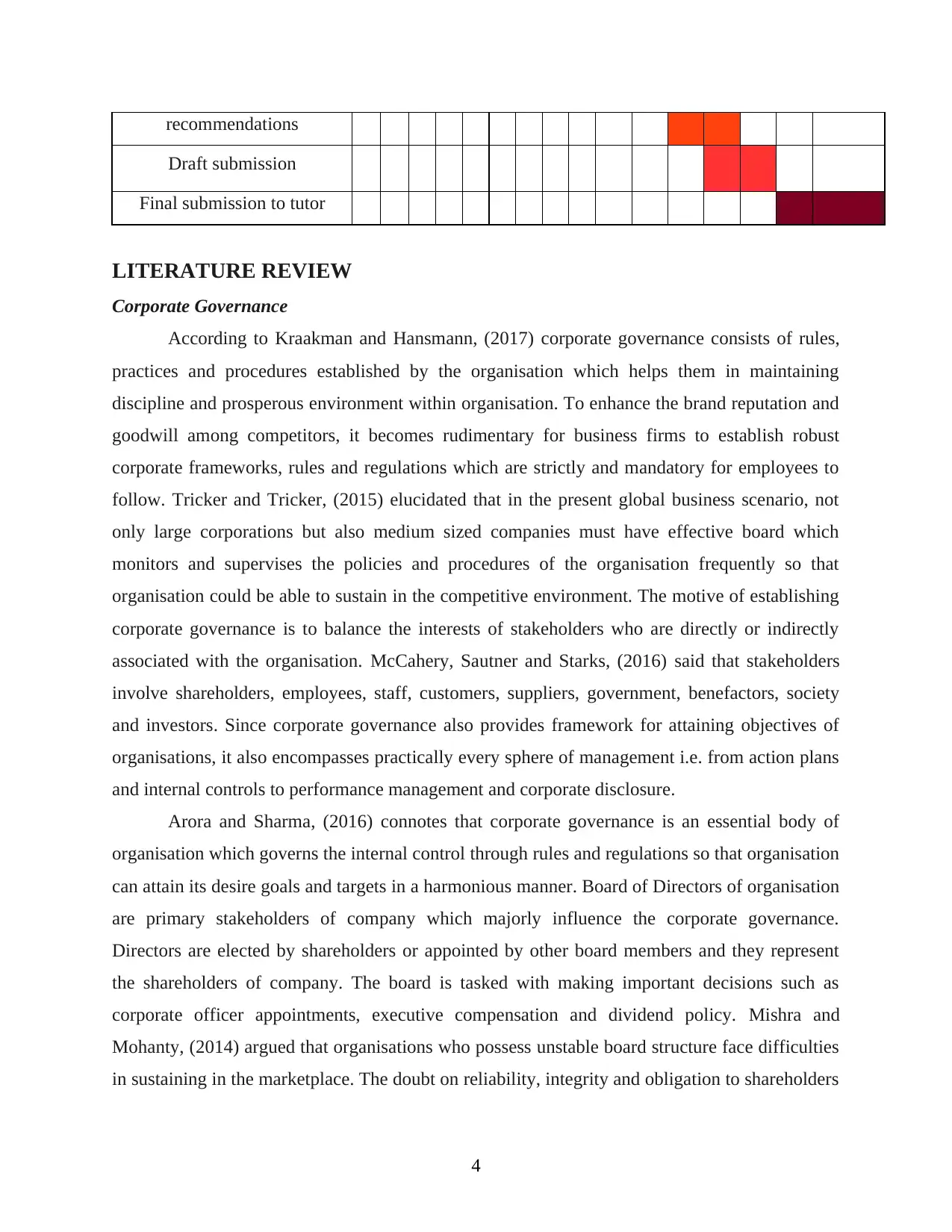
recommendations
Draft submission
Final submission to tutor
LITERATURE REVIEW
Corporate Governance
According to Kraakman and Hansmann, (2017) corporate governance consists of rules,
practices and procedures established by the organisation which helps them in maintaining
discipline and prosperous environment within organisation. To enhance the brand reputation and
goodwill among competitors, it becomes rudimentary for business firms to establish robust
corporate frameworks, rules and regulations which are strictly and mandatory for employees to
follow. Tricker and Tricker, (2015) elucidated that in the present global business scenario, not
only large corporations but also medium sized companies must have effective board which
monitors and supervises the policies and procedures of the organisation frequently so that
organisation could be able to sustain in the competitive environment. The motive of establishing
corporate governance is to balance the interests of stakeholders who are directly or indirectly
associated with the organisation. McCahery, Sautner and Starks, (2016) said that stakeholders
involve shareholders, employees, staff, customers, suppliers, government, benefactors, society
and investors. Since corporate governance also provides framework for attaining objectives of
organisations, it also encompasses practically every sphere of management i.e. from action plans
and internal controls to performance management and corporate disclosure.
Arora and Sharma, (2016) connotes that corporate governance is an essential body of
organisation which governs the internal control through rules and regulations so that organisation
can attain its desire goals and targets in a harmonious manner. Board of Directors of organisation
are primary stakeholders of company which majorly influence the corporate governance.
Directors are elected by shareholders or appointed by other board members and they represent
the shareholders of company. The board is tasked with making important decisions such as
corporate officer appointments, executive compensation and dividend policy. Mishra and
Mohanty, (2014) argued that organisations who possess unstable board structure face difficulties
in sustaining in the marketplace. The doubt on reliability, integrity and obligation to shareholders
4
Draft submission
Final submission to tutor
LITERATURE REVIEW
Corporate Governance
According to Kraakman and Hansmann, (2017) corporate governance consists of rules,
practices and procedures established by the organisation which helps them in maintaining
discipline and prosperous environment within organisation. To enhance the brand reputation and
goodwill among competitors, it becomes rudimentary for business firms to establish robust
corporate frameworks, rules and regulations which are strictly and mandatory for employees to
follow. Tricker and Tricker, (2015) elucidated that in the present global business scenario, not
only large corporations but also medium sized companies must have effective board which
monitors and supervises the policies and procedures of the organisation frequently so that
organisation could be able to sustain in the competitive environment. The motive of establishing
corporate governance is to balance the interests of stakeholders who are directly or indirectly
associated with the organisation. McCahery, Sautner and Starks, (2016) said that stakeholders
involve shareholders, employees, staff, customers, suppliers, government, benefactors, society
and investors. Since corporate governance also provides framework for attaining objectives of
organisations, it also encompasses practically every sphere of management i.e. from action plans
and internal controls to performance management and corporate disclosure.
Arora and Sharma, (2016) connotes that corporate governance is an essential body of
organisation which governs the internal control through rules and regulations so that organisation
can attain its desire goals and targets in a harmonious manner. Board of Directors of organisation
are primary stakeholders of company which majorly influence the corporate governance.
Directors are elected by shareholders or appointed by other board members and they represent
the shareholders of company. The board is tasked with making important decisions such as
corporate officer appointments, executive compensation and dividend policy. Mishra and
Mohanty, (2014) argued that organisations who possess unstable board structure face difficulties
in sustaining in the marketplace. The doubt on reliability, integrity and obligation to shareholders
4
⊘ This is a preview!⊘
Do you want full access?
Subscribe today to unlock all pages.

Trusted by 1+ million students worldwide
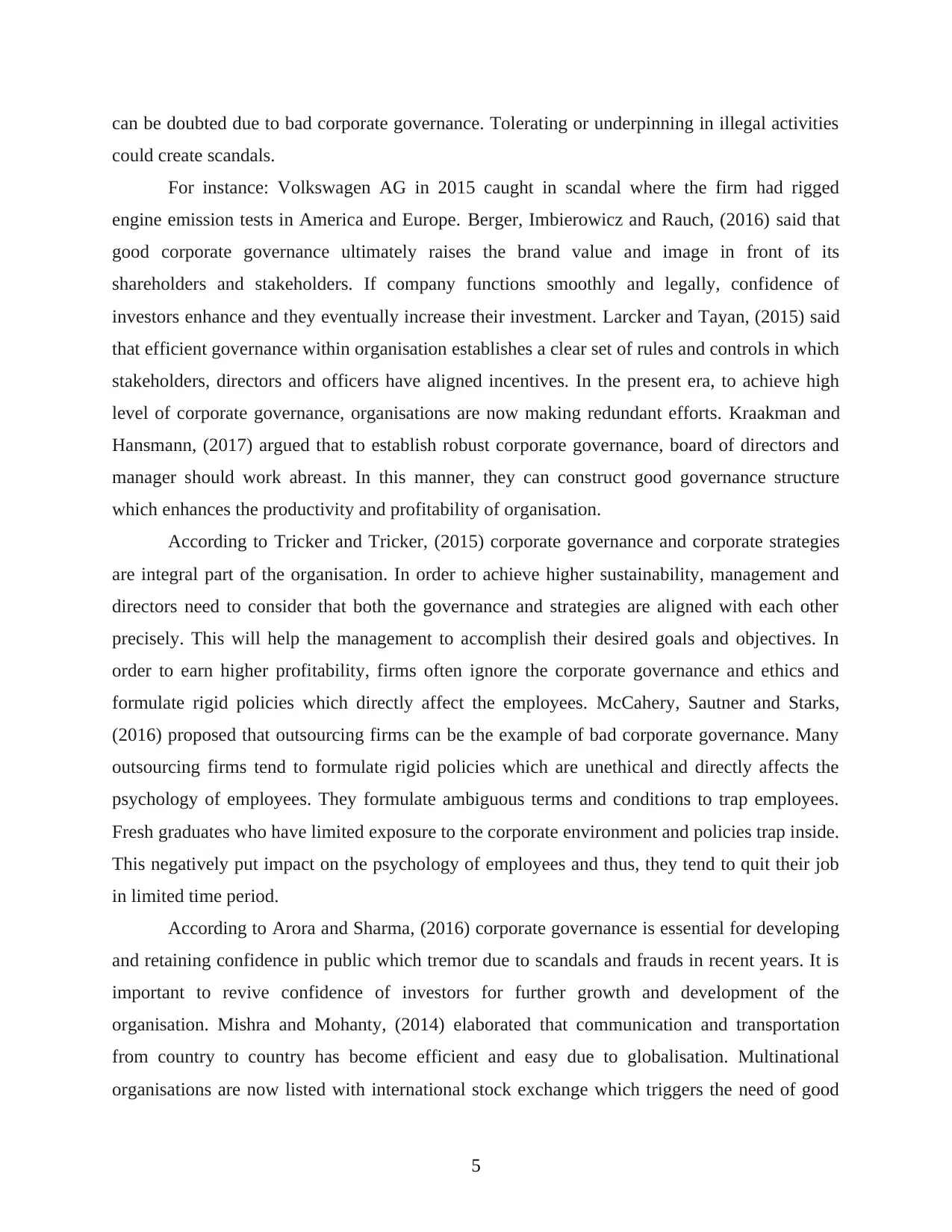
can be doubted due to bad corporate governance. Tolerating or underpinning in illegal activities
could create scandals.
For instance: Volkswagen AG in 2015 caught in scandal where the firm had rigged
engine emission tests in America and Europe. Berger, Imbierowicz and Rauch, (2016) said that
good corporate governance ultimately raises the brand value and image in front of its
shareholders and stakeholders. If company functions smoothly and legally, confidence of
investors enhance and they eventually increase their investment. Larcker and Tayan, (2015) said
that efficient governance within organisation establishes a clear set of rules and controls in which
stakeholders, directors and officers have aligned incentives. In the present era, to achieve high
level of corporate governance, organisations are now making redundant efforts. Kraakman and
Hansmann, (2017) argued that to establish robust corporate governance, board of directors and
manager should work abreast. In this manner, they can construct good governance structure
which enhances the productivity and profitability of organisation.
According to Tricker and Tricker, (2015) corporate governance and corporate strategies
are integral part of the organisation. In order to achieve higher sustainability, management and
directors need to consider that both the governance and strategies are aligned with each other
precisely. This will help the management to accomplish their desired goals and objectives. In
order to earn higher profitability, firms often ignore the corporate governance and ethics and
formulate rigid policies which directly affect the employees. McCahery, Sautner and Starks,
(2016) proposed that outsourcing firms can be the example of bad corporate governance. Many
outsourcing firms tend to formulate rigid policies which are unethical and directly affects the
psychology of employees. They formulate ambiguous terms and conditions to trap employees.
Fresh graduates who have limited exposure to the corporate environment and policies trap inside.
This negatively put impact on the psychology of employees and thus, they tend to quit their job
in limited time period.
According to Arora and Sharma, (2016) corporate governance is essential for developing
and retaining confidence in public which tremor due to scandals and frauds in recent years. It is
important to revive confidence of investors for further growth and development of the
organisation. Mishra and Mohanty, (2014) elaborated that communication and transportation
from country to country has become efficient and easy due to globalisation. Multinational
organisations are now listed with international stock exchange which triggers the need of good
5
could create scandals.
For instance: Volkswagen AG in 2015 caught in scandal where the firm had rigged
engine emission tests in America and Europe. Berger, Imbierowicz and Rauch, (2016) said that
good corporate governance ultimately raises the brand value and image in front of its
shareholders and stakeholders. If company functions smoothly and legally, confidence of
investors enhance and they eventually increase their investment. Larcker and Tayan, (2015) said
that efficient governance within organisation establishes a clear set of rules and controls in which
stakeholders, directors and officers have aligned incentives. In the present era, to achieve high
level of corporate governance, organisations are now making redundant efforts. Kraakman and
Hansmann, (2017) argued that to establish robust corporate governance, board of directors and
manager should work abreast. In this manner, they can construct good governance structure
which enhances the productivity and profitability of organisation.
According to Tricker and Tricker, (2015) corporate governance and corporate strategies
are integral part of the organisation. In order to achieve higher sustainability, management and
directors need to consider that both the governance and strategies are aligned with each other
precisely. This will help the management to accomplish their desired goals and objectives. In
order to earn higher profitability, firms often ignore the corporate governance and ethics and
formulate rigid policies which directly affect the employees. McCahery, Sautner and Starks,
(2016) proposed that outsourcing firms can be the example of bad corporate governance. Many
outsourcing firms tend to formulate rigid policies which are unethical and directly affects the
psychology of employees. They formulate ambiguous terms and conditions to trap employees.
Fresh graduates who have limited exposure to the corporate environment and policies trap inside.
This negatively put impact on the psychology of employees and thus, they tend to quit their job
in limited time period.
According to Arora and Sharma, (2016) corporate governance is essential for developing
and retaining confidence in public which tremor due to scandals and frauds in recent years. It is
important to revive confidence of investors for further growth and development of the
organisation. Mishra and Mohanty, (2014) elaborated that communication and transportation
from country to country has become efficient and easy due to globalisation. Multinational
organisations are now listed with international stock exchange which triggers the need of good
5
Paraphrase This Document
Need a fresh take? Get an instant paraphrase of this document with our AI Paraphraser
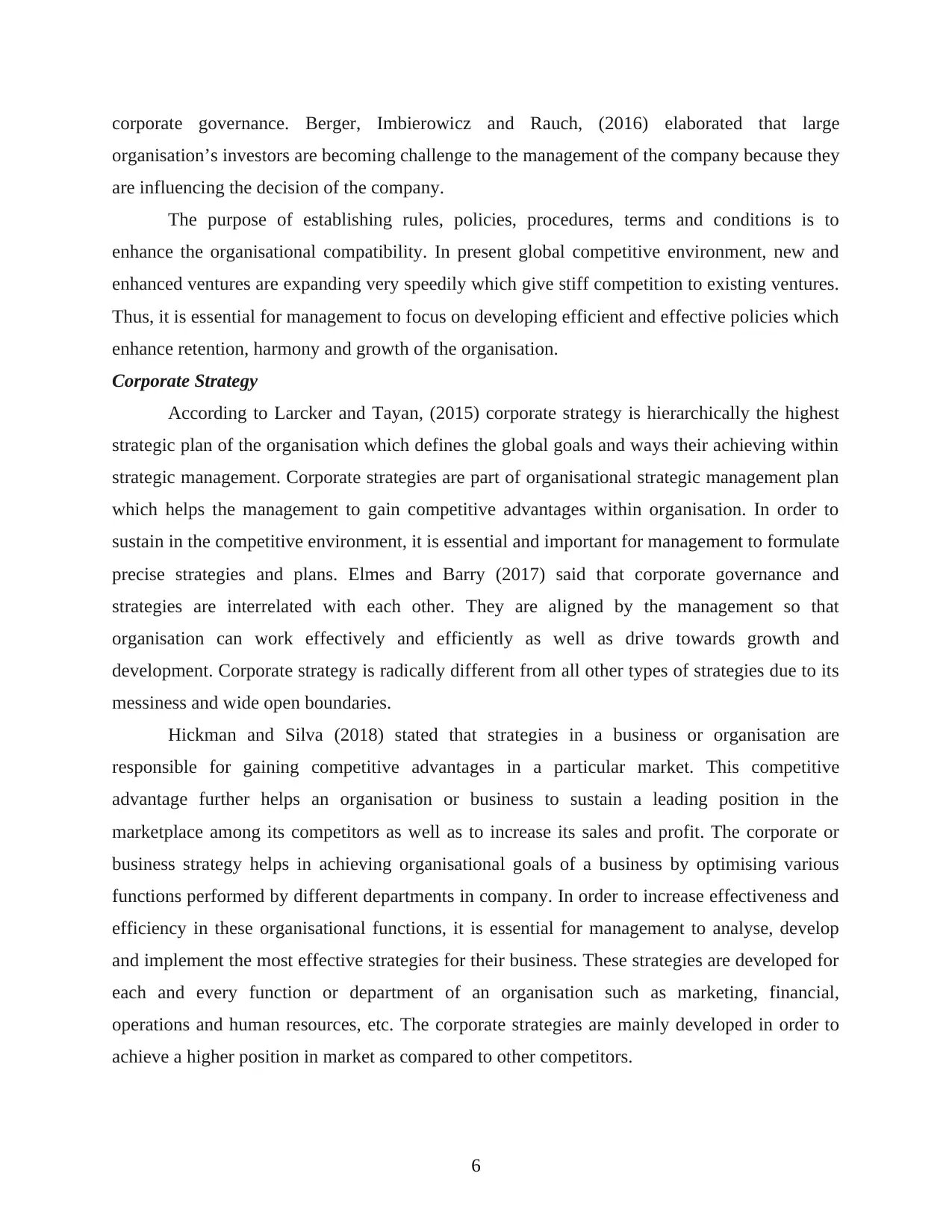
corporate governance. Berger, Imbierowicz and Rauch, (2016) elaborated that large
organisation’s investors are becoming challenge to the management of the company because they
are influencing the decision of the company.
The purpose of establishing rules, policies, procedures, terms and conditions is to
enhance the organisational compatibility. In present global competitive environment, new and
enhanced ventures are expanding very speedily which give stiff competition to existing ventures.
Thus, it is essential for management to focus on developing efficient and effective policies which
enhance retention, harmony and growth of the organisation.
Corporate Strategy
According to Larcker and Tayan, (2015) corporate strategy is hierarchically the highest
strategic plan of the organisation which defines the global goals and ways their achieving within
strategic management. Corporate strategies are part of organisational strategic management plan
which helps the management to gain competitive advantages within organisation. In order to
sustain in the competitive environment, it is essential and important for management to formulate
precise strategies and plans. Elmes and Barry (2017) said that corporate governance and
strategies are interrelated with each other. They are aligned by the management so that
organisation can work effectively and efficiently as well as drive towards growth and
development. Corporate strategy is radically different from all other types of strategies due to its
messiness and wide open boundaries.
Hickman and Silva (2018) stated that strategies in a business or organisation are
responsible for gaining competitive advantages in a particular market. This competitive
advantage further helps an organisation or business to sustain a leading position in the
marketplace among its competitors as well as to increase its sales and profit. The corporate or
business strategy helps in achieving organisational goals of a business by optimising various
functions performed by different departments in company. In order to increase effectiveness and
efficiency in these organisational functions, it is essential for management to analyse, develop
and implement the most effective strategies for their business. These strategies are developed for
each and every function or department of an organisation such as marketing, financial,
operations and human resources, etc. The corporate strategies are mainly developed in order to
achieve a higher position in market as compared to other competitors.
6
organisation’s investors are becoming challenge to the management of the company because they
are influencing the decision of the company.
The purpose of establishing rules, policies, procedures, terms and conditions is to
enhance the organisational compatibility. In present global competitive environment, new and
enhanced ventures are expanding very speedily which give stiff competition to existing ventures.
Thus, it is essential for management to focus on developing efficient and effective policies which
enhance retention, harmony and growth of the organisation.
Corporate Strategy
According to Larcker and Tayan, (2015) corporate strategy is hierarchically the highest
strategic plan of the organisation which defines the global goals and ways their achieving within
strategic management. Corporate strategies are part of organisational strategic management plan
which helps the management to gain competitive advantages within organisation. In order to
sustain in the competitive environment, it is essential and important for management to formulate
precise strategies and plans. Elmes and Barry (2017) said that corporate governance and
strategies are interrelated with each other. They are aligned by the management so that
organisation can work effectively and efficiently as well as drive towards growth and
development. Corporate strategy is radically different from all other types of strategies due to its
messiness and wide open boundaries.
Hickman and Silva (2018) stated that strategies in a business or organisation are
responsible for gaining competitive advantages in a particular market. This competitive
advantage further helps an organisation or business to sustain a leading position in the
marketplace among its competitors as well as to increase its sales and profit. The corporate or
business strategy helps in achieving organisational goals of a business by optimising various
functions performed by different departments in company. In order to increase effectiveness and
efficiency in these organisational functions, it is essential for management to analyse, develop
and implement the most effective strategies for their business. These strategies are developed for
each and every function or department of an organisation such as marketing, financial,
operations and human resources, etc. The corporate strategies are mainly developed in order to
achieve a higher position in market as compared to other competitors.
6
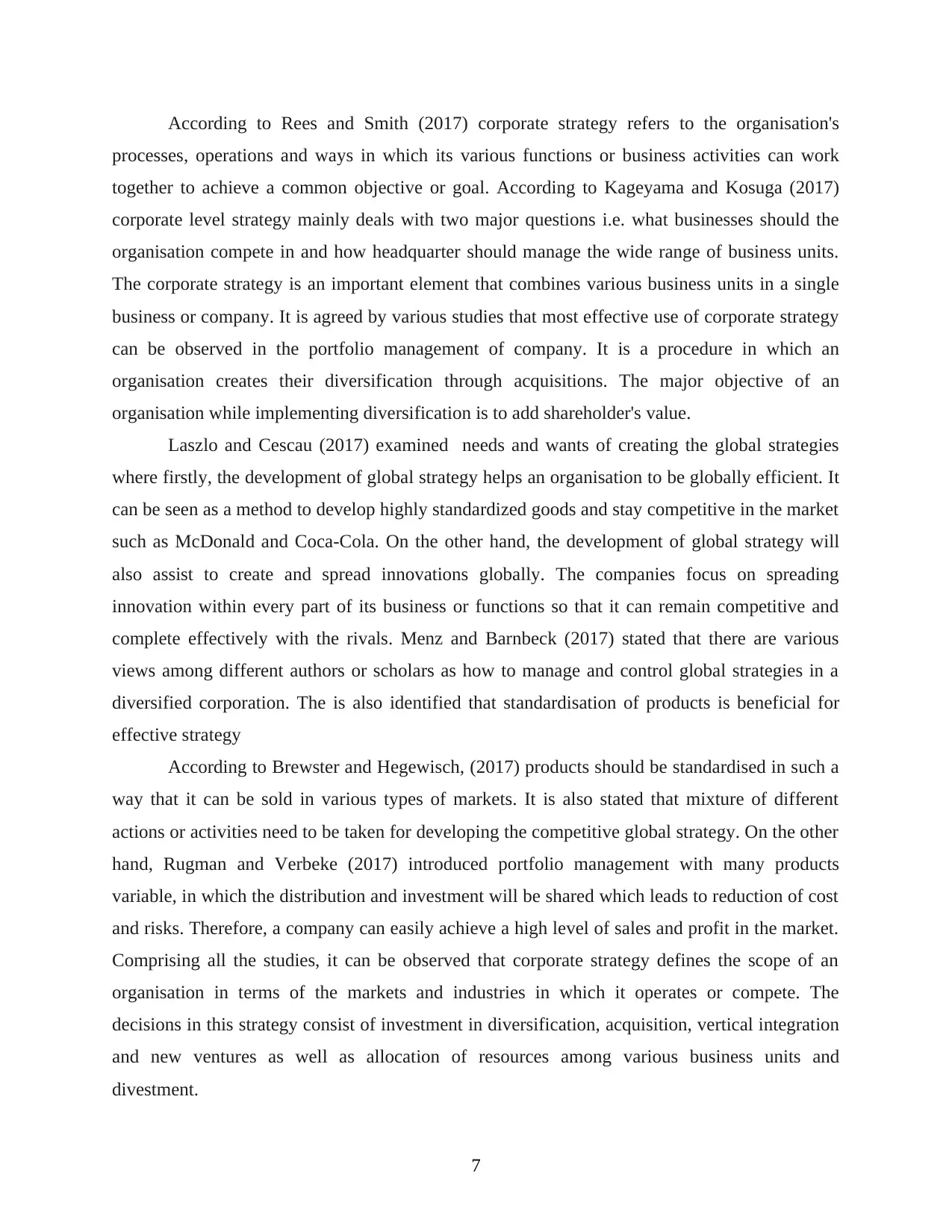
According to Rees and Smith (2017) corporate strategy refers to the organisation's
processes, operations and ways in which its various functions or business activities can work
together to achieve a common objective or goal. According to Kageyama and Kosuga (2017)
corporate level strategy mainly deals with two major questions i.e. what businesses should the
organisation compete in and how headquarter should manage the wide range of business units.
The corporate strategy is an important element that combines various business units in a single
business or company. It is agreed by various studies that most effective use of corporate strategy
can be observed in the portfolio management of company. It is a procedure in which an
organisation creates their diversification through acquisitions. The major objective of an
organisation while implementing diversification is to add shareholder's value.
Laszlo and Cescau (2017) examined needs and wants of creating the global strategies
where firstly, the development of global strategy helps an organisation to be globally efficient. It
can be seen as a method to develop highly standardized goods and stay competitive in the market
such as McDonald and Coca-Cola. On the other hand, the development of global strategy will
also assist to create and spread innovations globally. The companies focus on spreading
innovation within every part of its business or functions so that it can remain competitive and
complete effectively with the rivals. Menz and Barnbeck (2017) stated that there are various
views among different authors or scholars as how to manage and control global strategies in a
diversified corporation. The is also identified that standardisation of products is beneficial for
effective strategy
According to Brewster and Hegewisch, (2017) products should be standardised in such a
way that it can be sold in various types of markets. It is also stated that mixture of different
actions or activities need to be taken for developing the competitive global strategy. On the other
hand, Rugman and Verbeke (2017) introduced portfolio management with many products
variable, in which the distribution and investment will be shared which leads to reduction of cost
and risks. Therefore, a company can easily achieve a high level of sales and profit in the market.
Comprising all the studies, it can be observed that corporate strategy defines the scope of an
organisation in terms of the markets and industries in which it operates or compete. The
decisions in this strategy consist of investment in diversification, acquisition, vertical integration
and new ventures as well as allocation of resources among various business units and
divestment.
7
processes, operations and ways in which its various functions or business activities can work
together to achieve a common objective or goal. According to Kageyama and Kosuga (2017)
corporate level strategy mainly deals with two major questions i.e. what businesses should the
organisation compete in and how headquarter should manage the wide range of business units.
The corporate strategy is an important element that combines various business units in a single
business or company. It is agreed by various studies that most effective use of corporate strategy
can be observed in the portfolio management of company. It is a procedure in which an
organisation creates their diversification through acquisitions. The major objective of an
organisation while implementing diversification is to add shareholder's value.
Laszlo and Cescau (2017) examined needs and wants of creating the global strategies
where firstly, the development of global strategy helps an organisation to be globally efficient. It
can be seen as a method to develop highly standardized goods and stay competitive in the market
such as McDonald and Coca-Cola. On the other hand, the development of global strategy will
also assist to create and spread innovations globally. The companies focus on spreading
innovation within every part of its business or functions so that it can remain competitive and
complete effectively with the rivals. Menz and Barnbeck (2017) stated that there are various
views among different authors or scholars as how to manage and control global strategies in a
diversified corporation. The is also identified that standardisation of products is beneficial for
effective strategy
According to Brewster and Hegewisch, (2017) products should be standardised in such a
way that it can be sold in various types of markets. It is also stated that mixture of different
actions or activities need to be taken for developing the competitive global strategy. On the other
hand, Rugman and Verbeke (2017) introduced portfolio management with many products
variable, in which the distribution and investment will be shared which leads to reduction of cost
and risks. Therefore, a company can easily achieve a high level of sales and profit in the market.
Comprising all the studies, it can be observed that corporate strategy defines the scope of an
organisation in terms of the markets and industries in which it operates or compete. The
decisions in this strategy consist of investment in diversification, acquisition, vertical integration
and new ventures as well as allocation of resources among various business units and
divestment.
7
⊘ This is a preview!⊘
Do you want full access?
Subscribe today to unlock all pages.

Trusted by 1+ million students worldwide
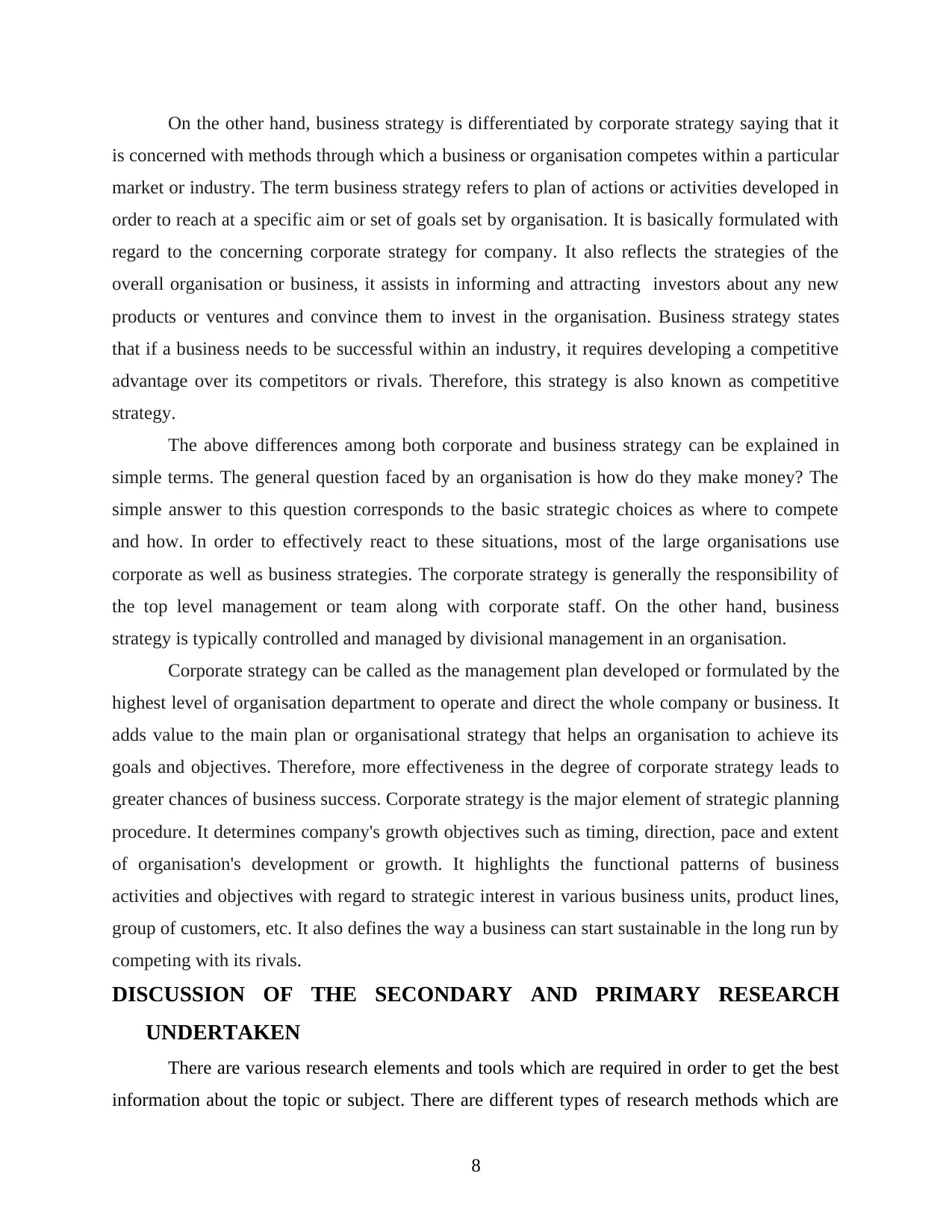
On the other hand, business strategy is differentiated by corporate strategy saying that it
is concerned with methods through which a business or organisation competes within a particular
market or industry. The term business strategy refers to plan of actions or activities developed in
order to reach at a specific aim or set of goals set by organisation. It is basically formulated with
regard to the concerning corporate strategy for company. It also reflects the strategies of the
overall organisation or business, it assists in informing and attracting investors about any new
products or ventures and convince them to invest in the organisation. Business strategy states
that if a business needs to be successful within an industry, it requires developing a competitive
advantage over its competitors or rivals. Therefore, this strategy is also known as competitive
strategy.
The above differences among both corporate and business strategy can be explained in
simple terms. The general question faced by an organisation is how do they make money? The
simple answer to this question corresponds to the basic strategic choices as where to compete
and how. In order to effectively react to these situations, most of the large organisations use
corporate as well as business strategies. The corporate strategy is generally the responsibility of
the top level management or team along with corporate staff. On the other hand, business
strategy is typically controlled and managed by divisional management in an organisation.
Corporate strategy can be called as the management plan developed or formulated by the
highest level of organisation department to operate and direct the whole company or business. It
adds value to the main plan or organisational strategy that helps an organisation to achieve its
goals and objectives. Therefore, more effectiveness in the degree of corporate strategy leads to
greater chances of business success. Corporate strategy is the major element of strategic planning
procedure. It determines company's growth objectives such as timing, direction, pace and extent
of organisation's development or growth. It highlights the functional patterns of business
activities and objectives with regard to strategic interest in various business units, product lines,
group of customers, etc. It also defines the way a business can start sustainable in the long run by
competing with its rivals.
DISCUSSION OF THE SECONDARY AND PRIMARY RESEARCH
UNDERTAKEN
There are various research elements and tools which are required in order to get the best
information about the topic or subject. There are different types of research methods which are
8
is concerned with methods through which a business or organisation competes within a particular
market or industry. The term business strategy refers to plan of actions or activities developed in
order to reach at a specific aim or set of goals set by organisation. It is basically formulated with
regard to the concerning corporate strategy for company. It also reflects the strategies of the
overall organisation or business, it assists in informing and attracting investors about any new
products or ventures and convince them to invest in the organisation. Business strategy states
that if a business needs to be successful within an industry, it requires developing a competitive
advantage over its competitors or rivals. Therefore, this strategy is also known as competitive
strategy.
The above differences among both corporate and business strategy can be explained in
simple terms. The general question faced by an organisation is how do they make money? The
simple answer to this question corresponds to the basic strategic choices as where to compete
and how. In order to effectively react to these situations, most of the large organisations use
corporate as well as business strategies. The corporate strategy is generally the responsibility of
the top level management or team along with corporate staff. On the other hand, business
strategy is typically controlled and managed by divisional management in an organisation.
Corporate strategy can be called as the management plan developed or formulated by the
highest level of organisation department to operate and direct the whole company or business. It
adds value to the main plan or organisational strategy that helps an organisation to achieve its
goals and objectives. Therefore, more effectiveness in the degree of corporate strategy leads to
greater chances of business success. Corporate strategy is the major element of strategic planning
procedure. It determines company's growth objectives such as timing, direction, pace and extent
of organisation's development or growth. It highlights the functional patterns of business
activities and objectives with regard to strategic interest in various business units, product lines,
group of customers, etc. It also defines the way a business can start sustainable in the long run by
competing with its rivals.
DISCUSSION OF THE SECONDARY AND PRIMARY RESEARCH
UNDERTAKEN
There are various research elements and tools which are required in order to get the best
information about the topic or subject. There are different types of research methods which are
8
Paraphrase This Document
Need a fresh take? Get an instant paraphrase of this document with our AI Paraphraser
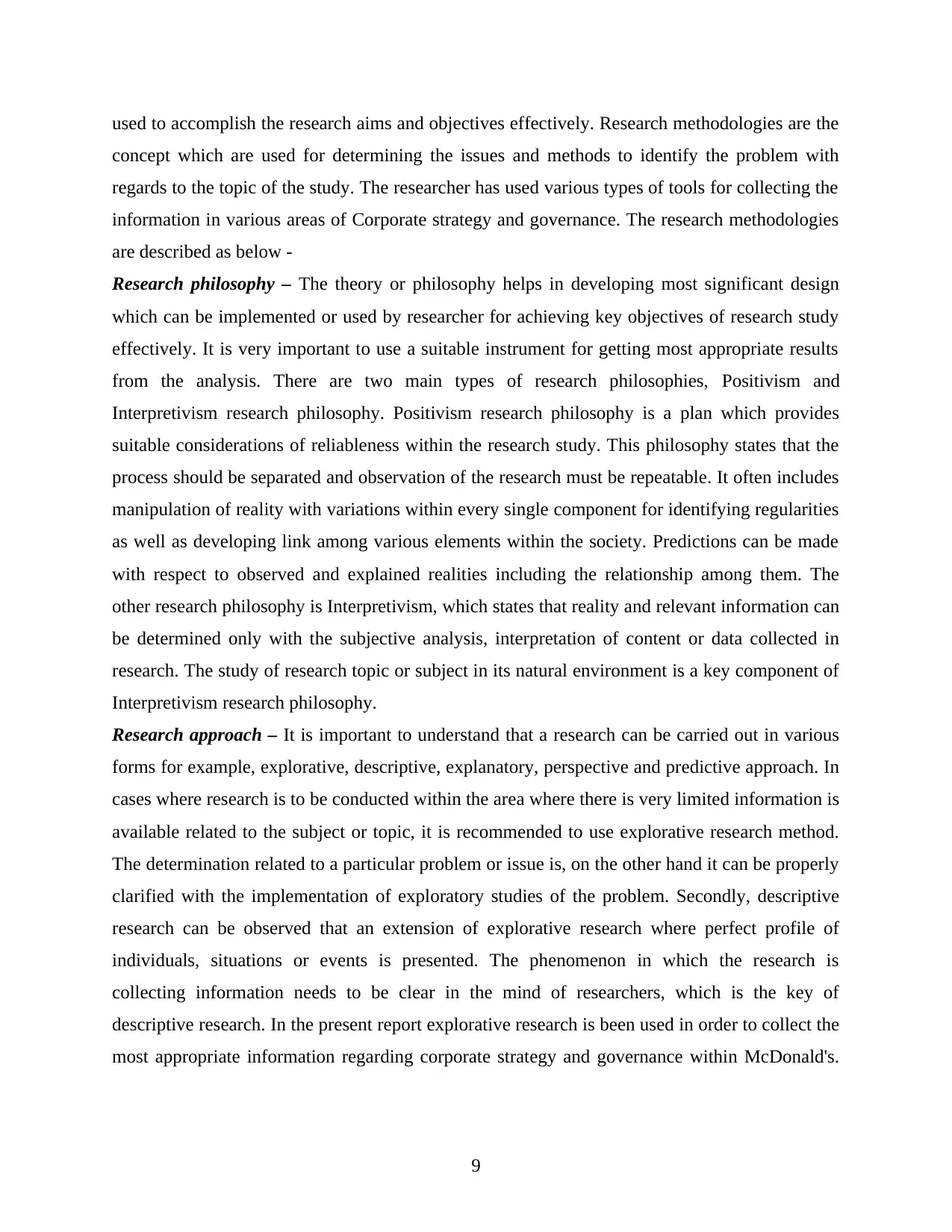
used to accomplish the research aims and objectives effectively. Research methodologies are the
concept which are used for determining the issues and methods to identify the problem with
regards to the topic of the study. The researcher has used various types of tools for collecting the
information in various areas of Corporate strategy and governance. The research methodologies
are described as below -
Research philosophy – The theory or philosophy helps in developing most significant design
which can be implemented or used by researcher for achieving key objectives of research study
effectively. It is very important to use a suitable instrument for getting most appropriate results
from the analysis. There are two main types of research philosophies, Positivism and
Interpretivism research philosophy. Positivism research philosophy is a plan which provides
suitable considerations of reliableness within the research study. This philosophy states that the
process should be separated and observation of the research must be repeatable. It often includes
manipulation of reality with variations within every single component for identifying regularities
as well as developing link among various elements within the society. Predictions can be made
with respect to observed and explained realities including the relationship among them. The
other research philosophy is Interpretivism, which states that reality and relevant information can
be determined only with the subjective analysis, interpretation of content or data collected in
research. The study of research topic or subject in its natural environment is a key component of
Interpretivism research philosophy.
Research approach – It is important to understand that a research can be carried out in various
forms for example, explorative, descriptive, explanatory, perspective and predictive approach. In
cases where research is to be conducted within the area where there is very limited information is
available related to the subject or topic, it is recommended to use explorative research method.
The determination related to a particular problem or issue is, on the other hand it can be properly
clarified with the implementation of exploratory studies of the problem. Secondly, descriptive
research can be observed that an extension of explorative research where perfect profile of
individuals, situations or events is presented. The phenomenon in which the research is
collecting information needs to be clear in the mind of researchers, which is the key of
descriptive research. In the present report explorative research is been used in order to collect the
most appropriate information regarding corporate strategy and governance within McDonald's.
9
concept which are used for determining the issues and methods to identify the problem with
regards to the topic of the study. The researcher has used various types of tools for collecting the
information in various areas of Corporate strategy and governance. The research methodologies
are described as below -
Research philosophy – The theory or philosophy helps in developing most significant design
which can be implemented or used by researcher for achieving key objectives of research study
effectively. It is very important to use a suitable instrument for getting most appropriate results
from the analysis. There are two main types of research philosophies, Positivism and
Interpretivism research philosophy. Positivism research philosophy is a plan which provides
suitable considerations of reliableness within the research study. This philosophy states that the
process should be separated and observation of the research must be repeatable. It often includes
manipulation of reality with variations within every single component for identifying regularities
as well as developing link among various elements within the society. Predictions can be made
with respect to observed and explained realities including the relationship among them. The
other research philosophy is Interpretivism, which states that reality and relevant information can
be determined only with the subjective analysis, interpretation of content or data collected in
research. The study of research topic or subject in its natural environment is a key component of
Interpretivism research philosophy.
Research approach – It is important to understand that a research can be carried out in various
forms for example, explorative, descriptive, explanatory, perspective and predictive approach. In
cases where research is to be conducted within the area where there is very limited information is
available related to the subject or topic, it is recommended to use explorative research method.
The determination related to a particular problem or issue is, on the other hand it can be properly
clarified with the implementation of exploratory studies of the problem. Secondly, descriptive
research can be observed that an extension of explorative research where perfect profile of
individuals, situations or events is presented. The phenomenon in which the research is
collecting information needs to be clear in the mind of researchers, which is the key of
descriptive research. In the present report explorative research is been used in order to collect the
most appropriate information regarding corporate strategy and governance within McDonald's.
9
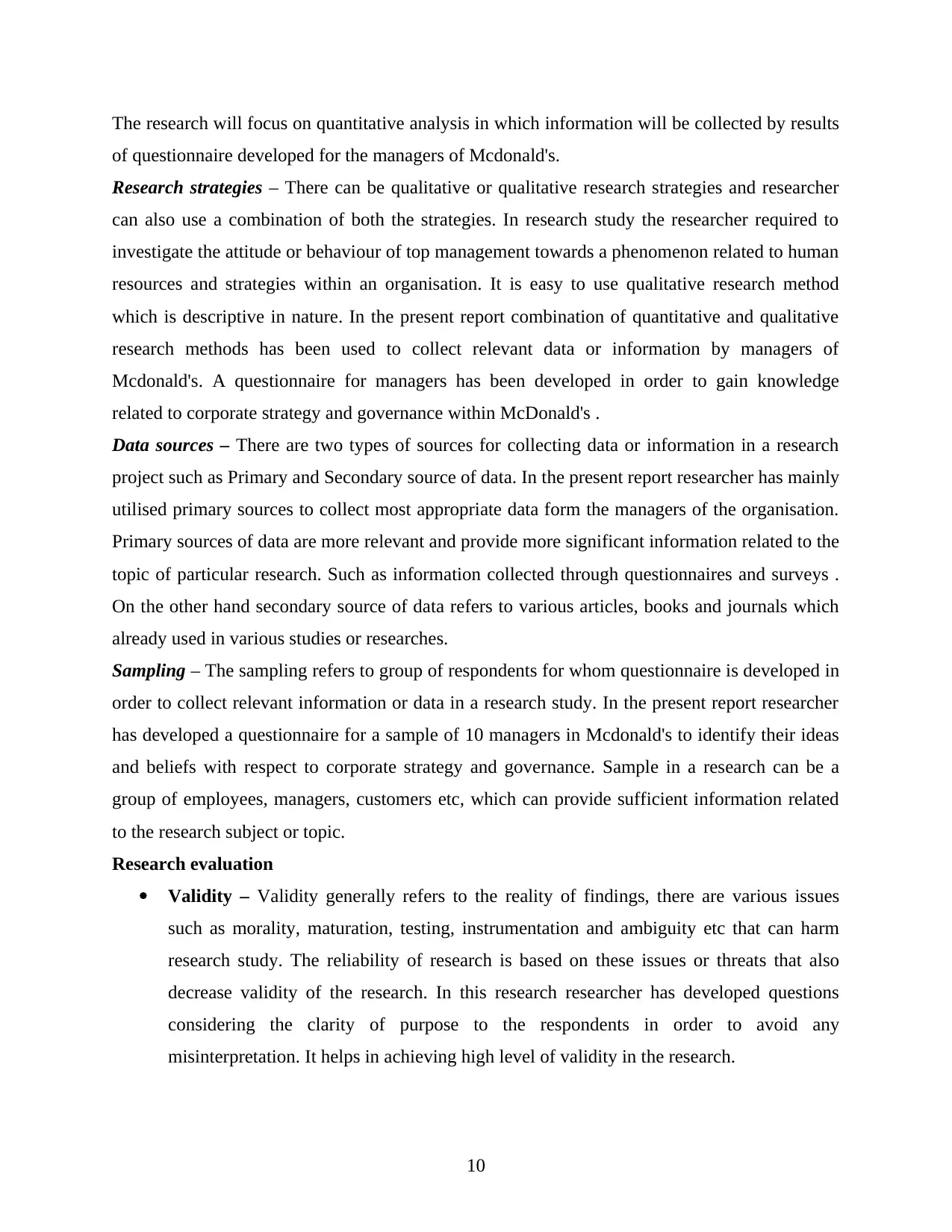
The research will focus on quantitative analysis in which information will be collected by results
of questionnaire developed for the managers of Mcdonald's.
Research strategies – There can be qualitative or qualitative research strategies and researcher
can also use a combination of both the strategies. In research study the researcher required to
investigate the attitude or behaviour of top management towards a phenomenon related to human
resources and strategies within an organisation. It is easy to use qualitative research method
which is descriptive in nature. In the present report combination of quantitative and qualitative
research methods has been used to collect relevant data or information by managers of
Mcdonald's. A questionnaire for managers has been developed in order to gain knowledge
related to corporate strategy and governance within McDonald's .
Data sources – There are two types of sources for collecting data or information in a research
project such as Primary and Secondary source of data. In the present report researcher has mainly
utilised primary sources to collect most appropriate data form the managers of the organisation.
Primary sources of data are more relevant and provide more significant information related to the
topic of particular research. Such as information collected through questionnaires and surveys .
On the other hand secondary source of data refers to various articles, books and journals which
already used in various studies or researches.
Sampling – The sampling refers to group of respondents for whom questionnaire is developed in
order to collect relevant information or data in a research study. In the present report researcher
has developed a questionnaire for a sample of 10 managers in Mcdonald's to identify their ideas
and beliefs with respect to corporate strategy and governance. Sample in a research can be a
group of employees, managers, customers etc, which can provide sufficient information related
to the research subject or topic.
Research evaluation
Validity – Validity generally refers to the reality of findings, there are various issues
such as morality, maturation, testing, instrumentation and ambiguity etc that can harm
research study. The reliability of research is based on these issues or threats that also
decrease validity of the research. In this research researcher has developed questions
considering the clarity of purpose to the respondents in order to avoid any
misinterpretation. It helps in achieving high level of validity in the research.
10
of questionnaire developed for the managers of Mcdonald's.
Research strategies – There can be qualitative or qualitative research strategies and researcher
can also use a combination of both the strategies. In research study the researcher required to
investigate the attitude or behaviour of top management towards a phenomenon related to human
resources and strategies within an organisation. It is easy to use qualitative research method
which is descriptive in nature. In the present report combination of quantitative and qualitative
research methods has been used to collect relevant data or information by managers of
Mcdonald's. A questionnaire for managers has been developed in order to gain knowledge
related to corporate strategy and governance within McDonald's .
Data sources – There are two types of sources for collecting data or information in a research
project such as Primary and Secondary source of data. In the present report researcher has mainly
utilised primary sources to collect most appropriate data form the managers of the organisation.
Primary sources of data are more relevant and provide more significant information related to the
topic of particular research. Such as information collected through questionnaires and surveys .
On the other hand secondary source of data refers to various articles, books and journals which
already used in various studies or researches.
Sampling – The sampling refers to group of respondents for whom questionnaire is developed in
order to collect relevant information or data in a research study. In the present report researcher
has developed a questionnaire for a sample of 10 managers in Mcdonald's to identify their ideas
and beliefs with respect to corporate strategy and governance. Sample in a research can be a
group of employees, managers, customers etc, which can provide sufficient information related
to the research subject or topic.
Research evaluation
Validity – Validity generally refers to the reality of findings, there are various issues
such as morality, maturation, testing, instrumentation and ambiguity etc that can harm
research study. The reliability of research is based on these issues or threats that also
decrease validity of the research. In this research researcher has developed questions
considering the clarity of purpose to the respondents in order to avoid any
misinterpretation. It helps in achieving high level of validity in the research.
10
⊘ This is a preview!⊘
Do you want full access?
Subscribe today to unlock all pages.

Trusted by 1+ million students worldwide
1 out of 31
Your All-in-One AI-Powered Toolkit for Academic Success.
+13062052269
info@desklib.com
Available 24*7 on WhatsApp / Email
![[object Object]](/_next/static/media/star-bottom.7253800d.svg)
Unlock your academic potential
Copyright © 2020–2025 A2Z Services. All Rights Reserved. Developed and managed by ZUCOL.

